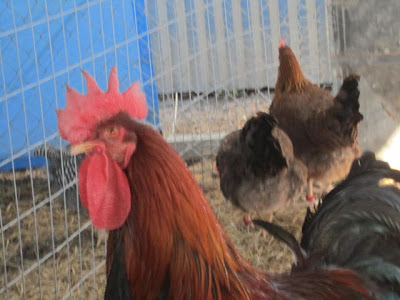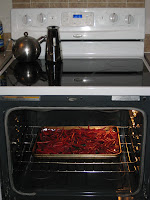 |
| chickens can eat dead weeds and scratch the soil |
O.K. gardeners this should of been done last month but its still not too late to bring inside tender plants to a frost free greenhouse, covered porch or patio, or basically anywhere where the plants can continue to get light, but avoid the frost and harshest of the cold weather. Stronger winter resistant plants should be covered with a nice layer of mulch to protect them. A good layer of bark-chips or straw will suffice for perennials that have died down, however, for larger plants; they will need some type of covering. I am also listing 8 other suggestions that I myself practice every winter.
- This is an excellent time to tend to other landscaping items. Give garden paths a good cleaning, especially making sure you give a lot of attention to once shaded areas where leaves need to be raked up. Take a look at your sheds and fences. Do they need any repairs? If not, maybe a coating of stain or paint could be applied.
- Protect your water pipes by wrapping them up in old rags, towels etc. anything to protect them from the coldest temperatures. You can also wrap up the faucet tightly with a thick cloth when it is not in use.
- Be sure to feed the birds. Wild birds that visit your garden really need your help now and over the next few months. Their natural food supplies are at their lowest and water sources can freeze. Do not allow birdbaths to freeze over. If they do freeze, crack the surface to let the birds get to the water below, or even better give them fresh water daily.
- If you have plants under mulch don't forget to water them. However, do so sparingly as plants require less water at this time of year while they are dormant. Over-watering can lead to rotting of the plant.
- Winter's a great time to let the chickens into the empty flower beds and garden plots so they can incorporate organic matter into the soil as you dig to improve the quality of the soil. Avoid digging in very wet weather when the soil is saturated.
- Now that all the fruit has been harvested from your fruit trees and bushes, take the time to spruce them up with any required pruning. Make sure to prune all shrubbery and vines such as grapes and berries now.
- Now’s the time to buy seeds and get great bargains. Most seed companies make their new stock available in late November or December. Take the time now to browse through their catalogues or visit gardening websites and buy the seeds you want to plant in the spring.
- Last but not least take a break. You've had a busy year, put your feet up on a footrest with a hot cup of green tea and watch an old rerun on television. You deserve a rest! And look forward to starting all over again in January.





























